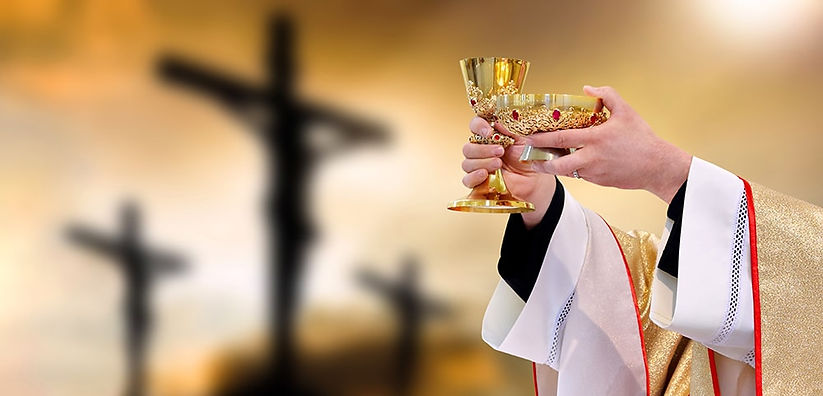top of page


"The liturgy is the summit toward which the activity of the church is directed; at the same time it is the fount from which all the Church's power flows."
Constitution on the Sacred Liturgy, #10
What is Liturgy?
Liturgy is the whole complex of official services, all the rites, ceremonies, prayers, and sacraments of the Church, as opposed to private devotions. Through Liturgy, we worship God in the way that God wants to be worshipped. Watch this video (and the episodes that follow) produced by the Liturgical Institute to deepen your understanding of Catholic Liturgy.
The Reason for the Seasons
Why do Catholics use a Liturgical Calendar? The liturgical calendar puts the universal Church on the same page so that we can celebrate and worship God in unison as the one Body of Christ. Moreover, the liturgical calendar allows the pilgrim Church on earth to unite our worship with heaven— our eternal home. Wherever we live, the liturgical calendar is something splendid that we’re all meant to celebrate and experience with joy. On a personal level, the liturgical calendar helps us order and structure our lives in a way that’s pleasing to God; a way that will bring His peace into our lives and souls; a way that points us to the happiness of heaven.
The Liturgical Seasons
Each liturgical year begins on the First Sunday of Advent during the preceding calendar year (i.e., the First Sunday of Advent in 2024 kicked off the 2025 liturgical year). The liturgical year is made up of six seasons: Advent, Christmas, Lent, the Sacred Paschal Triduum, Easter, and Ordinary Time.

Advent
Advent is derived from the Latin word that means “coming.”
It is during this four-week period that we journey into joyful preparation for the birth of Jesus Christ, our Lord. Advent highlights hope and joy with festive celebrations as we wait with delight for the coming of the Lord.
Christmas
Every 25th of December, we remember the birth of Jesus. The Nativity story tells us that Mary and Joseph had to travel from Nazareth to Bethlehem to register their child. Since there was no room at the Inn, Jesus was born in a stable. Jesus, the Son of God, our Savior, came to Earth for all people, symbolized through the visits of the wise men and the shepherds.


Lent
Lent is a time for us to reflect, repent, and pray as a way of preparing our hearts for Easter. Ash Wednesday marks the beginning of Lent with a day of fasting and abstinence; we receive a cross of ashes on our foreheads as a sign of our mortality and repentance. Traditionally, Lent lasts for 40 days of fasting and penitence, in commemoration of the 40 days Jesus spent fasting in the desert.




Sacred Paschal Triduum
Holy Week is the most solemn and glorious week in the Christian calendar— it is the pinnacle of the liturgical year. Holy Week begins with Palm Sunday (when Jesus made his final entrance into Jerusalem) and culminates with Easter Sunday.
As Holy Week progresses towards its final days, the tension heightens! This leads us to the Sacred Paschal Triduum— the holiest "three days" of the Church's year, where the Christian people recall the suffering, death, and resurrection of Jesus. Though chronologically three days, they are liturgically one day unfolding for us the unity of Christ's Paschal Mystery. The single celebration of the Triduum marks the end of the Lenten season; it begins with the Mass of the Lord's Supper on Holy Thursday, followed by the Good Friday of the Lord's Passion, and leads to the Mass of the Resurrection of the Lord at the Easter Vigil.
-
Holy Thursday commemorates the Last Supper of Jesus Christ. Jesus celebrated this Passover feast and became the sacrificial lamb so all would be saved by his final sacrifice. This meal also established the Sacrament of Holy Communion.
-
On Good Friday, Catholics are joined by all other Christians to commemorate the Crucifixion of Jesus Christ. Because Jesus died for our sins on that day, we see that it is indeed a “good” day.
-
The Easter Vigil is held after nightfall of Holy Saturday, or before dawn on Easter Day, in anticipation of the celebration of the Resurrection of Jesus. This is the most glorious, beautiful, and dramatic liturgy for the Church. As the sun rises so does the Son!
Easter
The season of Easter celebrates the Resurrection of Jesus Christ. Easter Sunday marks the beginning of the Easter season of the liturgical year. Easter marks the fulfillment of God’s promise to humankind, that whoever believes in God and follows Jesus’ teachings will have eternal life.


Ordinary Time
Sundays and weeks of Ordinary Time take us through the life of Jesus, and through a time of spiritual growth. The goal, toward which all of history is directed, is represented by the final Sunday in Ordinary Time, the Solemnity of Our Lord Jesus Christ, King of the Universe. The readings on this day show the great mystery of our faith: In the moment of his Crucifixion, Jesus is shown to be King and Saviour of all.
bottom of page